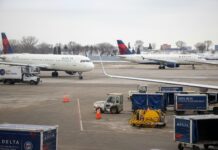Comparing Fires in Los Angeles and Las Vegas: Weather Patterns and Differences
In the midst of devastating wildfires in Los Angeles and Las Vegas, one crucial factor stands out: the impact of prolonged hot and dry weather conditions. Both cities have been grappling with extreme temperatures and arid climates, but what sets them apart in terms of fire risk and containment?
Las Vegas Weather Review: A Year of Heat and Dryness
Las Vegas weather in 2024 painted a picture of scorching temperatures and arid conditions, with an average of 72.3 degrees tying the record for the hottest year since official records began in 1937. The city experienced a staggering 112 days with temperatures exceeding 100 degrees and seven days hitting highs of 115 or more, with a record-setting peak of 120 degrees on July 7.
Precipitation levels in Las Vegas fell short of normal, with only 2.27 inches recorded compared to the average of 4.18 inches. The city endured 180 days without measurable rainfall, marking the second-longest dry streak in recorded weather history.
Meteorologist Julie Phillipson from the Las Vegas office of the National Weather Service highlighted that while Las Vegas and Los Angeles share hot and dry conditions, the presence of Santa Ana winds in Los Angeles poses an additional fire risk. Las Vegas, on the other hand, benefits from a lack of excessive combustible vegetation due to desert landscapes and water conservation efforts.
Fire Risk Factors: Vegetation, Wind, and Climate Change
The stark differences in vegetation density between Los Angeles and Las Vegas play a crucial role in fire containment. While Los Angeles hillsides are often densely populated with vegetation, Las Vegas’s desert environment and desert landscaping practices reduce the presence of dry leaves and dead plants that fuel fires.
Bronson Mack, spokesman for the Southern Nevada Water Authority, emphasized the impact of recent rainfall patterns on fire susceptibility, noting California’s significant decrease in precipitation leading to heightened flammability. Lack of irrigation in Las Vegas contributes to a lower risk of vegetation drying out and igniting fires.
Neil Lareau, a professor at the University of Nevada Reno, highlighted the critical role of weather forecasting in predicting wind events and dry fuel conditions that contribute to fire outbreaks. While advance warnings and pre-positioned resources help mitigate risks, the uncontrollable nature of wildfires poses challenges for containment efforts.
Climate Change and Power Lines: Unraveling the Causes
Climate scientists like Daniel Swain and John Abatzoglou emphasize the complexities of attributing Santa Ana winds and fire outbreaks to human-caused climate change. While jet stream fluctuations and temperature drops play a role in extreme weather patterns, the exact link to climate change remains under investigation.
The ignition of fires from power lines in growing urban areas like Los Angeles raises concerns about infrastructure and fire safety measures. As the investigation continues, understanding the interplay of weather, vegetation, and human activity becomes crucial in preventing future fire disasters.
In a world where climate change is an ever-present threat, the resilience of communities in adapting to extreme weather conditions and prioritizing fire prevention measures becomes paramount. As we navigate the challenges posed by wildfires, the role of science, technology, and public awareness in safeguarding lives and landscapes cannot be overstated.











